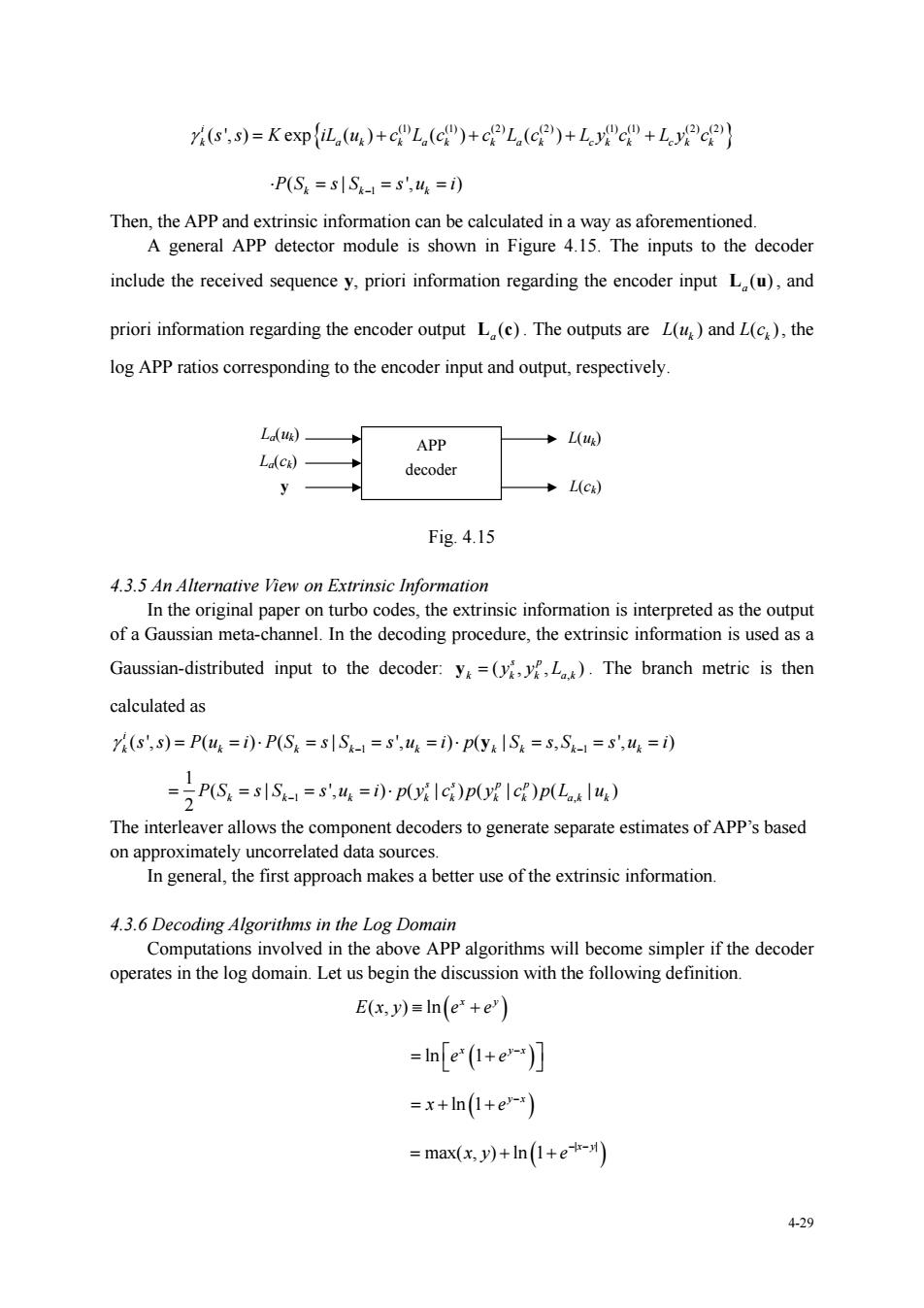正在加载图片...

ri(s',s)=K exp iL (u)+cL(c)+L(c)+Lc+Lc P(S4=sS=s',4=) Then,the APP and extrinsic information can be calculated in a way as aforementioned. A general APP detector module is shown in Figure 4.15.The inputs to the decoder include the received sequence y,priori information regarding the encoder input L(u),and priori information regarding the encoder output L(c).The outputs are L(and L(c),the log APP ratios corresponding to the encoder input and output,respectively. Ldu)_ APP decode y +L(c) Fig.4.15 4.3.5 An Alternative View on Extrinsic Information In the original paper on turbo codes,the extrinsic information is interpreted as the output of a Gaussian meta-channel.In the decoding procedure,the extrinsic information is used as a Gaussian-distributed input to the decoder:y=().The branch metric is then calculated as (s',s)=P(4=i)P(S=s|S1=s,4&=i)p(y:S=s,S-1=s,4=) =P(S,=sISpy)p(yi l)(u) on approximately uncorrelated data sources. In general,the first approach makes a better use of the extrinsic information. 4.3.6 Decoding Algorithms in the Log Domain Comp nvolved in the above APP algorithm swill become simpler if the decoder operates in the log domain.Let us begin the discussion with the following definition E(x,y)=ln(e+e) =lne'(1+e-)月 =x+ln(+e) =ma(x,y)+ln(1+e*-) 4-29 4-29 (1) (1) (2) (2) (1) (1) (2) (2) ( ', ) exp ( ) ( ) ( ) i k a k k a k k a k ck k ck k s s K iL u c L c c L c L y c L y c 1 ( | ', ) PS s S s u i kk k Then, the APP and extrinsic information can be calculated in a way as aforementioned. A general APP detector module is shown in Figure 4.15. The inputs to the decoder include the received sequence y, priori information regarding the encoder input ( ) L u a , and priori information regarding the encoder output ( ) L c a . The outputs are ( ) and ( ) Lu Lc k k , the log APP ratios corresponding to the encoder input and output, respectively. Fig. 4.15 4.3.5 An Alternative View on Extrinsic Information In the original paper on turbo codes, the extrinsic information is interpreted as the output of a Gaussian meta-channel. In the decoding procedure, the extrinsic information is used as a Gaussian-distributed input to the decoder: , (, , ) s p k k k ak y yyL . The branch metric is then calculated as 1 1 ( ', ) ( ) ( | ', ) ( | , ', ) i k k k k k kk k k s s Pu i PS s S s u i p S sS s u i y 1 , 1 ( | ', ) ( | ) ( | ) ( | ) 2 ss pp PS s S s u i py c py c pL u k k k k k k k ak k The interleaver allows the component decoders to generate separate estimates of APP’s based on approximately uncorrelated data sources. In general, the first approach makes a better use of the extrinsic information. 4.3.6 Decoding Algorithms in the Log Domain Computations involved in the above APP algorithms will become simpler if the decoder operates in the log domain. Let us begin the discussion with the following definition. ( , ) ln x y E xy e e ln 1 x yx e e ln 1 y x x e | | max( , ) ln 1 x y xy e APP decoder y La(ck) La(uk) L(uk) L(ck)